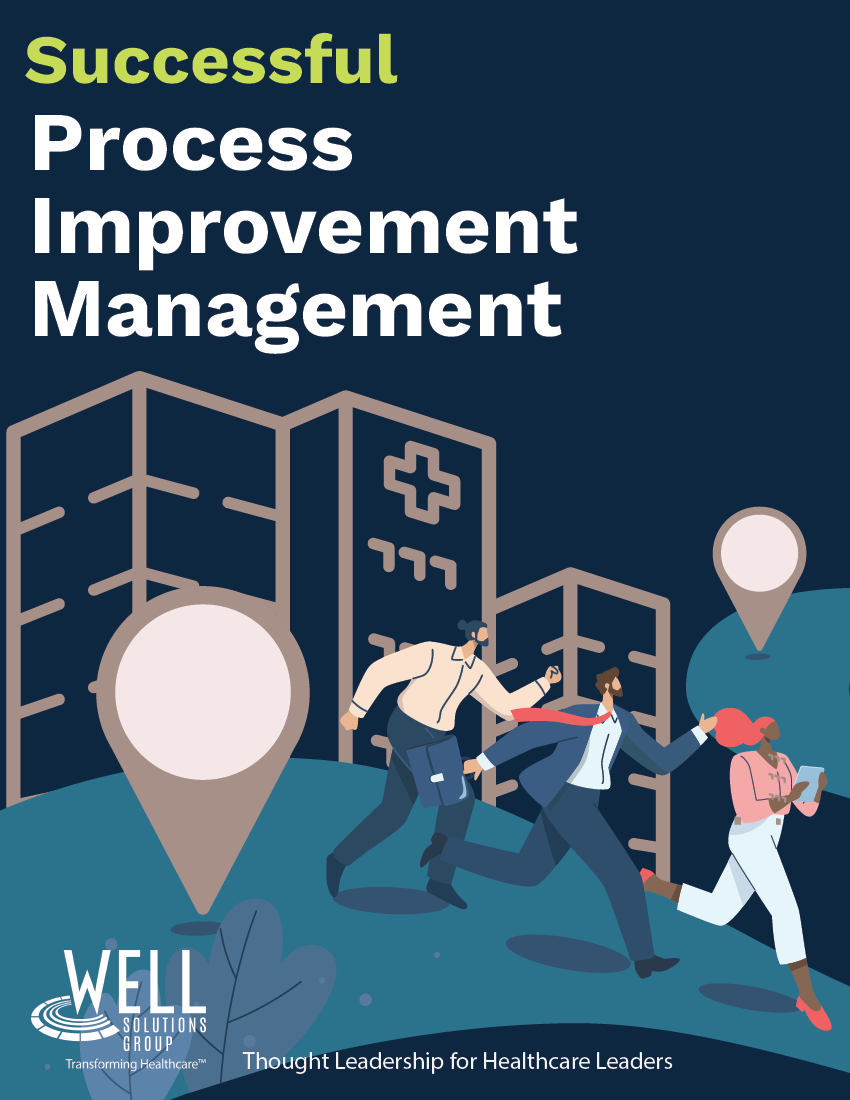Successful Process Improvement
January 2025
Well Solutions Group
It Takes Leadership
How process improvement is managed above and beyond what is done is a key ingredient for success and can make the difference between a well-executed improved process and one that fails to deliver demonstrative, sustainable results.
Our view of process improvement success is less about the process and tools mechanics and more on sharing insights on the leadership of the process – what are the management principles that come into play when the goal is to identify, plan and execute a successful process improvement initiative?
As a backdrop to help illustrate this perspective, we will leverage a recent successful process improvement engagement undertaken on behalf of one of our clients. Let’s start there.
billion DOLLARS in improper payments in fiscal year 2023
%
medical claims paid incorrectly each year.
%
of payers have 20% or more of claims needing rework
Healthcare Process Improvement: An Example
At Well Solutions Group, we were called upon to help a client who believed that patient outcomes in their specific field could be improved. Previous process improvement attempts were not universally effective or accepted and yielded inconsistent results.
“Prework” included understanding stakeholder perspectives. This included administrative and clinical leadership, as well as other influential individuals. We learned what they did and didn’t like about the existing programs and previous process improvement attempts. We also asked what aspects of the process were of greatest interest (see sidebar). We gained insight into the perspective of the client’s customers, although we didn’t directly contact them. (It’s not always possible to reach external customers, but if feasible, this can provide additional valuable information.)
This prework allowed us to:
- Confirm the stakeholders, including a likely sponsor and champion.
- Understand why and how they would support process improvements.
- Determine stakeholder support – the all-important “buy-in.”
We also assessed the current reality – what could not be changed, what key factors could impact project success, the reaction that stakeholders might have to “bad news” (what if the process was more “broken” than anticipated?), and “what could go wrong”—not only with the improvements but with the process of generating and implementing them.
Taking this time before jumping right into process improvement was a worthy investment. It is not always necessary or warranted; sometimes, “just do it” is the correct call.

We assessed the current reality – what could not be changed, what key factors could impact project success, the reaction of stakeholders to “bad news,” and “what could go wrong.
![process graphic [Converted]](https://wellsolutionsgroup.com/wp-content/uploads/2024/11/process-graphic-Converted.webp)
Part of process improvement leadership is communicating even “bad news.” It was quickly evident during the pre-work phase that reporting, which was meant for clinicians, was not only not being used but was instead seen as controlling and not useful. At the same time, there was a need to understand how the client’s various locations were performing on key metrics, including patient outcomes. It also became apparent that improving these outcomes was not a short-term opportunity. This was not necessarily what executives wanted to hear, and it was our role to present this information candidly in a fact-based way.
Improving engagement was seen as the key to improving outcomes. The process improvement path was aimed to turn around the “headquarters versus the field” perception that was a common thread of stakeholder interviews. This started with the introduction of:
- Provider self-assessment of development needs and interests. The client was large enough to accommodate both those who wanted to remain patient-focused and those who wanted to advance to leadership roles, but the client needed to know who wanted what.
- A formal protocol for acting on provider development, which included documentation of goals and steps to achieve them as well as regular meetings with local leadership.
- Shared accountability for the few key metrics that providers could actually impact.
- Venues where providers could meet regularly to share information and best practices and communicate wins at the individual and location level. This was challenging to implement since there were varying schedules and a mix of full-time and part-time clinicians at most locations across several time zones.
The results were encouraging. A pilot of the process improvements was well received and began to move the needle favorably in the metrics that were early indicators of better patient outcomes. What’s more, the participants in the pilot were eager to continue with the process changes, and spoke positively to peers outside the pilot area, creating a demand for these improvements. The “Net Promoter Score” among providers increased from before the pilot to after it was officially completed. In short, providers were more engaged than they were at the start of the pilot.
“participants in the pilot were eager to continue with the process changes, and spoke positively to peers outside the pilot area, creating a demand for these improvements.”
Process Improvement Success
A Guide to Managing Your Project:
Leadership Principles Underscore Process Improvement Project Success
Drawing from the project we’ve described here by way of example, what follows are leadership principles that, when incorporated effectively, can greatly increase the odds of smoothly run process improvement projects that end with breakthrough results.
Stakeholder and Sponsor/Champion Relationship Management:
A common thread for successful process improvement involves identifying and getting to know key stakeholders. The key word here is relationship. This implies more than just identifying and managing stakeholders, but making a connection that fosters a shared commitment and mutual trust. Time spent to get to know who your stakeholders are and what makes them tick pays off and is central to what an experienced process improvement professional brings to the table.
Organizational Readiness for Change (understand the context for the improvement initiative):
Is there something external to the process itself that might change the overall landscape?
Are there root causes for the problems to be solved that simply are not actionable – part of the existing reality outside the scope of improvement efforts?
Not all about the Tools:
As is best learned through experience, effective management of a process improvement effort is more about the expertise and skills of the leader than the tools themselves. There are times an immediate path to improve a process becomes clear early on.
In our own experience, we appreciate that our clients are busy managing their business, and our value derives from helping them get to the improvements they are looking for expediently versus trying to justify value via bringing a host of improvement tools to the table.
Testing and Experimentation:
It is hard work to improve results through process improvement. Processes are complicated, and many different variables have an impact – the complexity of the process, the number of hand-offs, the variety of stakeholders involved, and the accuracy of the measurements, to name just a few. To counteract marching down an improvement path that may not be able to produce measurable results in the near term, it is useful to start with a smaller-scale pilot.

“It is hard work to improve results through process improvement. Processes are complicated, and many different variables have an impact.”
Measuring Results
When it comes time to measure results, it is easier to detect a defect (and measure its improvement) with a product versus a service, as is often the case with the evaluation of clinical practice and population health management. Measuring service performance often requires relying on a softer metric like satisfaction. For this project, we worked with administrative and clinical stakeholders to develop an auxiliary set of metrics as measures of success, having to do with both patient and provider satisfaction (Net Promoter Scoring), alongside measures of patient outcomes. This helped foster a mutual appreciation of the importance of provider enthusiasm and commitment to the overall program’s success.
For additional information and guidance on leveraging operational data and process analytics and selecting the right measurements to gauge success, please reference our articles from this past year on those topics. Case Study – Leveraging Operational Data and Process Analytics for Efficient Delivery and Managing with the Right Metrics

In Summary
In summary, as stated upfront, how process improvement is managed above and beyond what is done is a key ingredient for success and can make the difference between a well-executed improved process and one that fails to deliver demonstrative, sustainable results.
Indispensable leadership principles central to successful management of a process improvement initiative relate to a few fundamentals:
- Relationship building with key stakeholders fostering mutual commitment to project goals and objectives.
- Setting expectations and ensuring organization is primed to remain curious and prepared to make changes as needed to improve the process and yield desired results.
- Less about the tools – sometimes the path to improvement is learned early on and does not always require implementing the entire process improvement tool set to get to the best result.
- Starting with smaller scale pilot (test case) – well worth the extra time as one or several well designed pilots will allow for adjustments and greater confidence in ultimate solution(s) for improving the process.


